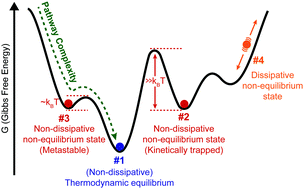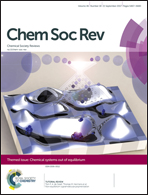Non-equilibrium supramolecular polymerization
Abstract
Supramolecular polymerization has been traditionally focused on the thermodynamic equilibrium state, where one-dimensional assemblies reside at the global minimum of the Gibbs free energy. The pathway and rate to reach the equilibrium state are irrelevant, and the resulting assemblies remain unchanged over time. In the past decade, the focus has shifted to kinetically trapped (non-dissipative non-equilibrium) structures that heavily depend on the method of preparation (i.e., pathway complexity), and where the assembly rates are of key importance. Kinetic models have greatly improved our understanding of competing pathways, and shown how to steer supramolecular polymerization in the desired direction (i.e., pathway selection). The most recent innovation in the field relies on energy or mass input that is dissipated to keep the system away from the thermodynamic equilibrium (or from other non-dissipative states). This tutorial review aims to provide the reader with a set of tools to identify different types of self-assembled states that have been explored so far. In particular, we aim to clarify the often unclear use of the term “non-equilibrium self-assembly” by subdividing systems into dissipative, and non-dissipative non-equilibrium states. Examples are given for each of the states, with a focus on non-dissipative non-equilibrium states found in one-dimensional supramolecular polymerization.

- This article is part of the themed collection: Chemical systems out of equilibrium


 Please wait while we load your content...
Please wait while we load your content...